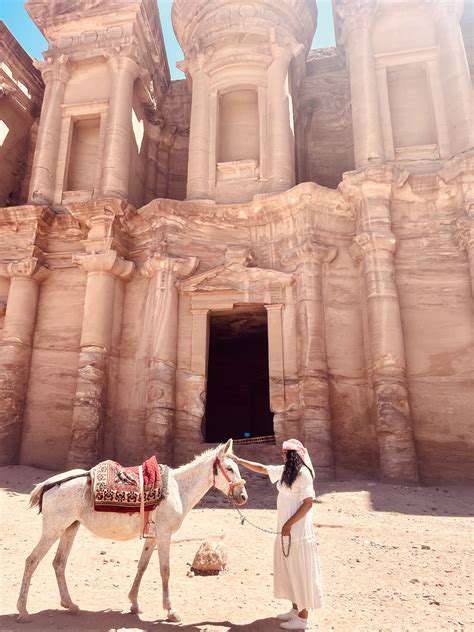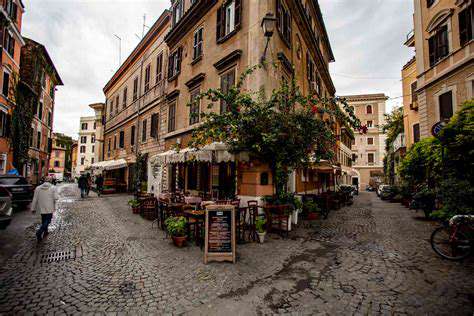Your Guide to Exploring the Ancient City of Petra, Jordan
Early Inhabitants and Nabataean Rise
Petra's story begins long before the grandeur of the city we see today. Archaeological evidence suggests that the area was inhabited by various groups, but the Nabataeans, a nomadic Arab tribe, arrived in the region around the 4th century BCE. They quickly recognized the strategic importance of the Siq, a narrow gorge leading to the city, and transformed it into a vital trading hub. This strategic location, coupled with their ingenuity in water management, allowed them to flourish and build a civilization renowned for its innovation and resilience.
The Siq: A Gateway to Wonder
The Siq, a narrow and winding gorge, is a truly remarkable natural feature that serves as the gateway to Petra. As visitors navigate the Siq, they are gradually introduced to the breathtaking architecture and artistry that await them. The walls of the gorge, sculpted by centuries of erosion, create a dramatic and awe-inspiring atmosphere, building anticipation for the grandeur of the city beyond. This gradual unveiling of the beauty within is a carefully orchestrated experience that enhances the overall impact of the site.
Water Management: A Key to Survival
The Nabataean civilization was deeply reliant on water. The unique topography of the region, characterized by harsh desert conditions, necessitated ingenious water management techniques. They carved intricate channels and cisterns to collect and store rainwater, ensuring a reliable water supply for their community. This remarkable understanding of the environment allowed the Nabataean people to thrive in a seemingly inhospitable landscape, showcasing their profound connection to and mastery over their surroundings.
The Treasury (Al-Khazna): A Symbol of Petra
Arguably the most iconic structure in Petra, the Treasury, or Al-Khazna, stands as a testament to the Nabataean architectural prowess. Its intricate facade, adorned with sculpted figures and detailed carvings, is a marvel of ancient artistry. The sheer scale and beauty of the Treasury have captivated travelers and historians for centuries, inspiring awe and wonder at the skill and creativity of the Nabataean people. Its fame continues to draw visitors from around the world to experience its splendor.
Beyond the Treasury: A City of Wonders
While the Treasury is undoubtedly the highlight for many, Petra boasts a multitude of other remarkable structures. From the Monastery, another impressive rock-cut monument, to the numerous tombs and temples, the city is a treasure trove of ancient history. Each structure tells a story, revealing aspects of Nabataean life, beliefs, and artistry. Exploring these diverse monuments provides a deeper understanding of the city's rich and multifaceted past.
The Roman Influence and Decline
In 106 CE, the Roman Empire conquered Petra. This period marked a significant shift in the city's trajectory. While Roman influence brought about some changes in the city's governance, the Nabataean culture and traditions continued to thrive for a time. However, the decline of the Silk Road trade routes and other factors contributed to Petra's gradual decline in importance, eventually leading to its abandonment. Understanding this historical transition is crucial to appreciating the city's complex legacy.
Petra's Significance Today: A Global Treasure
Today, Petra stands as a UNESCO World Heritage Site, a testament to the enduring legacy of the Nabataean civilization. It serves as a powerful reminder of the ingenuity and artistry of ancient cultures. Millions of visitors from around the globe come to marvel at its beauty and history. Petra's significance extends beyond its historical context; it represents a global cultural heritage that inspires appreciation for the past and its connection to our present.
Exploring the Iconic Siq and Treasury: A Must-See Experience
Unveiling the Majestic Siq
The Siq, a narrow gorge carved into the sandstone cliffs, is a breathtaking prelude to the iconic Treasury. Its dramatic walls, sculpted by millennia of wind and water, create a mystical atmosphere. The changing light filtering through the narrow passageways casts shifting shadows on the ancient rock formations, transforming the experience into something truly unforgettable. Walking through the Siq is like stepping back in time, a sensory journey into the heart of ancient Nabataean civilization. The sheer scale and beauty of the Siq are a testament to the natural wonders of the region and a fitting introduction to the wonders that await.
As you progress deeper into the Siq, the anticipation builds. The air grows hushed, and the sense of discovery sharpens. This narrow passageway, while seemingly simple, is deeply symbolic. It represents the journey of discovery itself, leading visitors to the ultimate destination - a captivating spectacle of human ingenuity and architectural prowess.
A Glimpse into the Treasury's Majesty
The Treasury, also known as Al-Khazneh, is undoubtedly the most famous landmark in Petra. This stunning rock-cut facade, adorned with intricate carvings and detailed reliefs, is a marvel of Nabataean architecture. The sheer artistry and precision of the carvings are astounding, showcasing the advanced craftsmanship of the ancient people who inhabited this region. Its grandeur and beauty have captivated visitors for centuries, making it a must-see destination for anyone exploring the ancient world.
Imagine standing before this magnificent structure, basking in the radiant sun or experiencing the gentle embrace of the evening. The Treasury's allure transcends mere aesthetics; it evokes a sense of wonder and awe, transporting you to a bygone era. The intricate details, the sheer scale, and the historical significance of this monumental structure make it a truly unforgettable experience.
Delving into the History and Culture
Petra's history is deeply interwoven with the Nabataean culture, a remarkable civilization that thrived in the region from the 4th century BCE to the 1st century CE. Understanding the context behind the Siq and the Treasury is key to appreciating their significance. The Nabataeans were skilled traders and master architects, and their ingenuity is evident in the intricate water systems and impressive structures they created. The region served as a crucial crossroads, connecting various trade routes and contributing significantly to the cultural tapestry of the ancient world.
Exploring Petra is not just about admiring the architecture; it's about immersing yourself in a historical and cultural narrative. The stories etched into the very stones of Petra whisper tales of trade, resilience, and the enduring spirit of a civilization that once thrived in this remarkable landscape. The Nabataean legacy continues to inspire and fascinate, beckoning visitors to explore the depths of their history and culture.
Practical Considerations for Your Visit
Petra is a popular tourist destination, so planning ahead is crucial for a smooth and enjoyable experience. Book your tickets in advance, especially during peak season, to avoid long queues. Consider the weather conditions and dress appropriately for the desert environment. Remember to bring plenty of water and sunscreen, and take breaks in shaded areas. Wear comfortable shoes, as you'll be doing a fair amount of walking. The sheer scale of Petra demands a thoughtful approach to managing your time. Allow ample time to explore each area and take in the beauty of this incredible site.
Engage with local guides or researchers to gain a deeper understanding of the historical context of the site. Their insights can illuminate the intricate details of the architecture and the lives of the people who once inhabited this region. With careful planning, you can truly appreciate the magnitude of Petra's historical significance and the splendor of its iconic landmarks.

Categorize your belongings into essential, occasional, and decorative items. This categorization will help you make informed decisions about what to keep, donate, or discard. Prioritizing essentials will help you avoid overwhelming your space with unnecessary items.
Practical Tips for Planning Your Petra Adventure

Prioritizing Tasks and Setting Realistic Goals
Effective planning hinges on recognizing your priorities and setting realistic expectations. Identifying the most crucial tasks and tackling them first can significantly boost productivity and reduce stress. This involves understanding your personal work style and identifying potential roadblocks. A well-defined to-do list, broken down into smaller, manageable steps, can make overwhelming projects feel more approachable. Remember, setting realistic goals is equally important. Overambitious plans often lead to frustration and decreased motivation. Instead, focus on achievable milestones that contribute to the overall objective.
Planning ahead also requires a keen understanding of your available time and resources. Don't underestimate the importance of scheduling breaks and allocating sufficient time for each task. This proactive approach ensures you stay on track and maintain a healthy work-life balance. By acknowledging potential interruptions and allocating buffer time, you can better manage unexpected delays and stay on schedule. Ultimately, prioritizing and setting realistic goals are fundamental steps for successful project planning.
Time Management Techniques for Efficiency
Employing effective time management techniques is crucial for maximizing your productivity. Consider strategies like the Pomodoro Technique, where you work in focused bursts with short breaks in between. This method promotes concentration and helps maintain energy levels throughout the day. Experiment with different time management techniques to find what works best for you. Understanding your peak productivity times can also significantly improve your efficiency. Scheduling tasks that require high concentration during those times can optimize your output.
Another valuable technique is to use a planner or digital calendar to schedule tasks and appointments. This visual representation of your day can help you stay organized and on track. Regularly reviewing your schedule and adjusting it as needed is key to maintaining a smooth workflow. This proactive approach allows you to adapt to changing priorities and unforeseen circumstances.
Resource Allocation and Budgeting (if applicable)
For projects that involve resources, accurate allocation is essential. Determining the necessary materials, tools, and personnel is a vital step in planning. Thorough research and careful consideration of potential costs can prevent unexpected budget overruns. Creating a detailed budget, outlining anticipated expenses, can help you stay within your financial constraints. This proactive approach can avoid unpleasant surprises later on.
Consider the availability of resources, both internal and external. Identifying potential bottlenecks and having contingency plans in place can prevent delays and ensure smooth execution. Clear communication with team members or vendors regarding resource availability is crucial for successful project management. A well-defined resource allocation strategy is critical for smooth project progression.
Adaptability and Contingency Planning
Planning is not a static process; it's a dynamic one. Unexpected challenges and changing circumstances are inevitable, and a flexible approach to planning is essential for success. Building in flexibility allows for course corrections when necessary, ensuring that your plans remain relevant and effective. Adapting to changes in scope, priorities, or timelines is crucial for maintaining momentum and achieving your goals.
Develop contingency plans to address potential setbacks or obstacles. Anticipating potential problems can help you develop proactive solutions. Regularly evaluating your progress and making adjustments as needed is a critical aspect of effective planning. By remaining adaptable and prepared, you can navigate challenges and maintain a positive trajectory.



![Top 10 Adventure Destinations in the World [2025]](/static/images/27/2025-05/ConqueringtheHimalayas3AMountaineeringandTrekkinginNepal.jpg)



![Best Trails for Mountain Biking [Destinations]](/static/images/27/2025-05/BritishColumbia27sCoastalTrails3AAPacificNorthwestEscape.jpg)



